View in other NatureServe Network Field Guides
NatureServe
Montana
Utah
Wyoming
Idaho
Wisconsin
British Columbia
South Carolina
Yukon
California
New York
Melissa Blue - Plebejus melissa
General Description
[From Ferris and Brown 1981; Scott 1986; Opler and Wright 1999; Glasberg 2001; Pyle 2002] Forewing 1.2-1.5 cm. Sexes dimorphic. Uppersurface of male blue, female brown with submarginal orange trim on both wings; undersurface of both wings with continuous black line on outer edge of iridescent blue-green points distal to red-orange submarginal band, submarginal band usually extending onto forewings, black points where hindwing veins intersect black marginal line, fringes uncheckered.
Phenology
Several flights, late May to early September in the southern mountains, otherwise April to October southward; one flight, late June to July in Alberta, mid-July to mid-August at higher elevations (Scott 1986). Mainly two flights, May to September but one flight at higher elevations (Glassberg 2001). April to October in the southern Rocky Mountain region (Ferris and Brown 1981), early May to mid-September in Colorado (Scott and Scott 1978), late April to late September in Oregon and Washington (Pyle 2002), early May through September in Oregon (Warren 2005), mid-May to early September in British Columbia (Guppy and Shepard 2001).
Diagnostic Characteristics
Best determined by combination of uppersurface of male blue, female brown with submarginal orange trim on both wings, undersurface with continuous black line on outer edge of iridescent blue-green points distal to red-orange submarginal band, submarginal band usually extending onto forewings.
Species Range
Montana Range
Range Descriptions

 Native
Native
Range Comments
Southern British Columbia east to southern Manitoba, south through the western US to northern Baja, western Texas, and mainland Mexico, mainly plains and intermountain areas; also scattered populations in upper Midwest and northeastern US (Scott 1986; Opler and Wright 1999; Glassberg 2001; Pyle 2002); 1310 m to 3230 m elevation but usually under 2743 m in Colorado (Scott and Scott 1978; Ferris and Brown 1981), usually below 914 m elevation in Oregon and Washington (Pyle 2002), 26 m to at least 2255 m elevation but usually less than 1371 m in Oregon (Warren 2005), below 305 m elevation in British Columbia (Guppy and Shepard 2001). In Montana, reported from all counties in the state (Kohler 1980; Stanford and Opler 1993). Common (Glassberg 2001).
Observations in Montana Natural Heritage Program Database
Number of Observations: 32
(Click on the following maps and charts to see full sized version)
Map Help and Descriptions
Relative Density
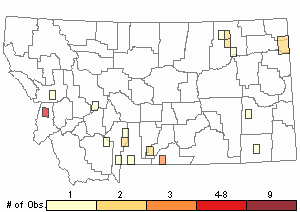
Recency
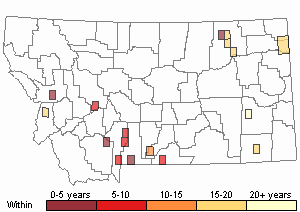
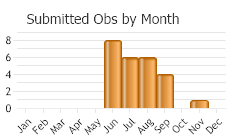
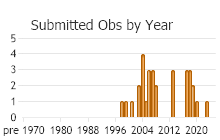
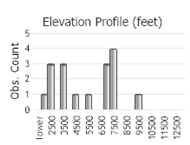 (Observations spanning multiple months or years are excluded from time charts)
(Observations spanning multiple months or years are excluded from time charts)
Migration
Non-migratory.
Habitat
Native prairie, dry montane meadows, alfalfa fields, weedy areas, fallow fields, sagebrush steppe (Scott 1986; Opler and Wright 1999; Glassberg 2001; Pyle 2002). In the Greater Yellowstone Ecosystem, reported in xeric montane meadows dominated by sagebrush (Debinski et al. 2013).
Food Habits
Larval food plants include several species of Astragalus, Glycyrrhiza, Hedysarum, Lotus, several species of Lupinus, Medicago, Oxytropis, Sphaerophysa, Swainsona, and Vicea (Ferris and Brown 1981; Scott 1986, 1992, 2006; Pyle 2002; Warren 2005; James and Nunnallee 2011). Adults feed on flower nectar (including Achillea, Allium, Astragalus, Barbarea, Berteroa, Ceanothus, Centaurea, Chrysothamnus, Cirsium, Croton, Dalea, Delphinium, Erigeron, Eriogonum, Erysimum, Grindelia, Gutierrezia, Heterotheca, Hymenopappus, Hymenoxys, Kuhnia, Lesquerella, Liatris, Linum, Lygodesmia, Machaeranthera, Medicago, Melilotus, Oxytropis, Potentilla, Psoralea, Rorippa, Sedum, Senecio, Solidago, Symphyotrichum, Trifolium, Verbena, Viguiera), urine, and mud (Pyle 2002; Scott 2014).
Reproductive Characteristics
Females lay eggs singly on host plant stem, underside of leaflet, in debris or on grass blade near base of plant (Scott 1986, 1992, 2006). Number of eggs per ovariole (1/8 of total) about 60 (Ehrlich and Ehrlich 1978). Eggs hatch in about 8 days, develop to L4 instar and pupate in about 24 days after oviposition (16 days after egg-hatch), adults eclose (emerge from pupae) in 8 days. Other eggs diapause (overwinter), hatch in about 3 days after exiting diapause. Larvae do not construct nest, feed nocturnally, retreat under base of host plant during day, are often attended by ants. Pupation occurs under host plant in soil and under basal leaves (Warren 2005; James and Nunnallee 2011). Report that larvae or pupae may overwinter (Scott 1979) apparently is incorrect and was later corrected (Scott 1986, 1992). Males patrol throughout the day near host plants in search of females (Scott 1975b, 1986; James and Nunnalee 2011).
References
- Literature Cited AboveLegend:
 View Online Publication
View Online Publication Debinski, D.M., J.C. Caruthers, D. Cook, J. Crowley, and H. Wickham. 2013. Gradient-based habitat affinities predict species vulnerability to drought. Ecology 94(5): 1036-1045.
Debinski, D.M., J.C. Caruthers, D. Cook, J. Crowley, and H. Wickham. 2013. Gradient-based habitat affinities predict species vulnerability to drought. Ecology 94(5): 1036-1045. Ehrlich, A.H. and P.R. Ehrlich. 1978. Reproductive strategies in the butterflies: I. Mating frequency, plugging, and egg number. Journal of the Kansas Entomological Society 51(4): 666-697.
Ehrlich, A.H. and P.R. Ehrlich. 1978. Reproductive strategies in the butterflies: I. Mating frequency, plugging, and egg number. Journal of the Kansas Entomological Society 51(4): 666-697. Ferris, C.D. and F.M. Brown (eds). 1981. Butterflies of the Rocky Mountains. Univ. of Oklahoma Press. Norman. 442 pp.
Ferris, C.D. and F.M. Brown (eds). 1981. Butterflies of the Rocky Mountains. Univ. of Oklahoma Press. Norman. 442 pp. Glassberg, J. 2001. Butterflies through Binoculars: A Field Guide to the Butterflies of Western North America. Oxford University Press.
Glassberg, J. 2001. Butterflies through Binoculars: A Field Guide to the Butterflies of Western North America. Oxford University Press. Guppy, C.S. and J.H. Shepard. 2001. Butterflies of British Columbia: including western Alberta, southern Yukon, the Alaska Panhandle, Washington, northern Oregon, northern Idaho, northwestern Montana. UBC Press (Vancouver, BC) and Royal British Columbia Museum (Victoria, BC). 414 pp.
Guppy, C.S. and J.H. Shepard. 2001. Butterflies of British Columbia: including western Alberta, southern Yukon, the Alaska Panhandle, Washington, northern Oregon, northern Idaho, northwestern Montana. UBC Press (Vancouver, BC) and Royal British Columbia Museum (Victoria, BC). 414 pp. James, D.G. and D. Nunnallee. 2011. Life histories of Cascadia butterflies. Corvallis, OR: Oregon State University Press. 447 p.
James, D.G. and D. Nunnallee. 2011. Life histories of Cascadia butterflies. Corvallis, OR: Oregon State University Press. 447 p. Kohler, S. 1980. Checklist of Montana Butterflies (Rhopalocera). Journal of the Lepidopterists' Society 34(1): 1-19.
Kohler, S. 1980. Checklist of Montana Butterflies (Rhopalocera). Journal of the Lepidopterists' Society 34(1): 1-19. Opler, P.A. and A.B. Wright. 1999. A field guide to western butterflies. Second edition. Peterson Field Guides. Houghton Mifflin Company, Boston, Massachusetts. 540 pp.
Opler, P.A. and A.B. Wright. 1999. A field guide to western butterflies. Second edition. Peterson Field Guides. Houghton Mifflin Company, Boston, Massachusetts. 540 pp. Pyle, R.M. 2002. The butterflies of Cascadia: a field guide to all the species of Washington, Oregon, and surrounding territories. Seattle Audubon Society, Seattle, Washington. 420 pp.
Pyle, R.M. 2002. The butterflies of Cascadia: a field guide to all the species of Washington, Oregon, and surrounding territories. Seattle Audubon Society, Seattle, Washington. 420 pp. Scott, J.A. 1975b. Mate-locating behavior of western North American butterflies. Journal of Research on the Lepidoptera 14:1-40.
Scott, J.A. 1975b. Mate-locating behavior of western North American butterflies. Journal of Research on the Lepidoptera 14:1-40. Scott, J.A. 1979. Hibernal diapause of North American Papilionoidea and Hesperioidea. Journal of Research on the Lepidoptera 18(3): 171-200.
Scott, J.A. 1979. Hibernal diapause of North American Papilionoidea and Hesperioidea. Journal of Research on the Lepidoptera 18(3): 171-200. Scott, J.A. 1986. The butterflies of North America: a natural history and field guide. Stanford University Press, Stanford, California.
Scott, J.A. 1986. The butterflies of North America: a natural history and field guide. Stanford University Press, Stanford, California. Scott, J.A. 1992. Hostplant records for butterflies and skippers (mostly from Colorado) 1959-1992, with new life histories and notes on oviposition, immatures, and ecology. Papilio new series #6. 185 p.
Scott, J.A. 1992. Hostplant records for butterflies and skippers (mostly from Colorado) 1959-1992, with new life histories and notes on oviposition, immatures, and ecology. Papilio new series #6. 185 p. Scott, J.A. 2006. Butterfly hostplant records, 1992-2005, with a treatise on the evolution of Erynnis, and a note on new terminology for mate-locating behavior. Papilio new series #14. 74 p.
Scott, J.A. 2006. Butterfly hostplant records, 1992-2005, with a treatise on the evolution of Erynnis, and a note on new terminology for mate-locating behavior. Papilio new series #14. 74 p. Scott, J.A. 2014. Lepidoptera of North America 13. Flower visitation by Colorado butterflies (40,615 records) with a review of the literature on pollination of Colorado plants and butterfly attraction (Lepidoptera: Hersperioidea and Papilionoidea). Contributions of the C.P. Gillette Museum of Arthopod Diversity. Fort Collins, CO: Colorado State University. 190 p.
Scott, J.A. 2014. Lepidoptera of North America 13. Flower visitation by Colorado butterflies (40,615 records) with a review of the literature on pollination of Colorado plants and butterfly attraction (Lepidoptera: Hersperioidea and Papilionoidea). Contributions of the C.P. Gillette Museum of Arthopod Diversity. Fort Collins, CO: Colorado State University. 190 p. Scott, J.A. and G.R. Scott. 1978. Ecology and distribution of the butterflies of southern central Colorado. Journal of Research on the Lepidoptera 17(2): 73-128.
Scott, J.A. and G.R. Scott. 1978. Ecology and distribution of the butterflies of southern central Colorado. Journal of Research on the Lepidoptera 17(2): 73-128. Stanford, R.E. and P.A. Opler. 1993. Atlas of western USA butterflies: including adjacent parts of Canada and Mexico. Unpubl. Report. Denver and Fort Collins, Colorado 275 pp.
Stanford, R.E. and P.A. Opler. 1993. Atlas of western USA butterflies: including adjacent parts of Canada and Mexico. Unpubl. Report. Denver and Fort Collins, Colorado 275 pp. Warren, A.D. 2005. Lepidoptera of North America 6: Butterflies of Oregon, their taxonomy, distribution, and biology. Contributions of the C. P. Gillette Museum of Arthropod Diversity, Colorado State University. Fort Collins, Colorado. 406 pp.
Warren, A.D. 2005. Lepidoptera of North America 6: Butterflies of Oregon, their taxonomy, distribution, and biology. Contributions of the C. P. Gillette Museum of Arthropod Diversity, Colorado State University. Fort Collins, Colorado. 406 pp.
- Additional ReferencesLegend:
 View Online Publication
View Online Publication
Do you know of a citation we're missing? Allen, T.J., J.P. Brock, and J. Glassberg. 2005. Caterpillars in the field and garden: a field guide to the butterfly caterpillars of North America. Oxford University Press.
Allen, T.J., J.P. Brock, and J. Glassberg. 2005. Caterpillars in the field and garden: a field guide to the butterfly caterpillars of North America. Oxford University Press. Brock, J.P. and K. Kaufman. 2003. Kaufman Field Guide to Butterflies of North America. Houghton Mifflin Company, New York, NY 284 pp.
Brock, J.P. and K. Kaufman. 2003. Kaufman Field Guide to Butterflies of North America. Houghton Mifflin Company, New York, NY 284 pp. Caruthers, J.C., and D. Debinski. 2006. Montane meadow butterfly species distributions in the Greater Yellowstone Ecosystem. University of Wyoming National Park Service Research Center Annual Report, 2006. Vol. 30, Art. 14. 85-96.
Caruthers, J.C., and D. Debinski. 2006. Montane meadow butterfly species distributions in the Greater Yellowstone Ecosystem. University of Wyoming National Park Service Research Center Annual Report, 2006. Vol. 30, Art. 14. 85-96. Hendricks, P. and M. Roedel. 2001. A faunal survey of the Centennial Valley Sandhills, Beaverhead County, Montana. Report to the U.S. Bureau of Land Management and U.S. Fish and Wildlife Service. Montana Natural Heritage Program, Helena, MT. 44 p.
Hendricks, P. and M. Roedel. 2001. A faunal survey of the Centennial Valley Sandhills, Beaverhead County, Montana. Report to the U.S. Bureau of Land Management and U.S. Fish and Wildlife Service. Montana Natural Heritage Program, Helena, MT. 44 p. Maxell, B.A. 2016. Northern Goshawk surveys on the Beartooth, Ashland, and Sioux Districts of the Custer-Gallatin National Forest: 2012-2014. Montana Natural Heritage Program. Helena, MT. 114pp.
Maxell, B.A. 2016. Northern Goshawk surveys on the Beartooth, Ashland, and Sioux Districts of the Custer-Gallatin National Forest: 2012-2014. Montana Natural Heritage Program. Helena, MT. 114pp. Sater, S. 2022. The insects of Sevenmile Creek, a pictorial guide to their diversity and ecology. Undergraduate Thesis. Helena, MT: Carroll College. 242 p.
Sater, S. 2022. The insects of Sevenmile Creek, a pictorial guide to their diversity and ecology. Undergraduate Thesis. Helena, MT: Carroll College. 242 p.
- Web Search Engines for Articles on "Melissa Blue"
- Additional Sources of Information Related to "Insects"





